The Dengue Virus Nonstructural Protein 1 (NS1) Is Secreted from Mosquito Cells in Association with the Intracellular Cholesterol Transporter Chaperone Caveolin Complex
- PMID: 30463973
- PMCID: PMC6364000
- DOI: 10.1128/JVI.01985-18
The Dengue Virus Nonstructural Protein 1 (NS1) Is Secreted from Mosquito Cells in Association with the Intracellular Cholesterol Transporter Chaperone Caveolin Complex
Abstract
Dengue virus (DENV) is a mosquito-borne virus of the family Flaviviridae The RNA viral genome encodes three structural and seven nonstructural proteins. Nonstructural protein 1 (NS1) is a multifunctional protein actively secreted in vertebrate and mosquito cells during infection. In mosquito cells, NS1 is secreted in a caveolin-1-dependent manner by an unconventional route. The caveolin chaperone complex (CCC) is a cytoplasmic complex formed by caveolin-1 and the chaperones FKBP52, Cy40, and CyA and is responsible for the cholesterol traffic inside the cell. In this work, we demonstrate that in mosquito cells, but not in vertebrate cells, NS1 associates with and relies on the CCC for secretion. Treatment of mosquito cells with classic secretion inhibitors, such as brefeldin A, Golgicide A, and Fli-06, showed no effect on NS1 secretion but significant reductions in recombinant luciferase secretion and virion release. Silencing the expression of CAV-1 or FKBP52 with short interfering RNAs or the inhibition of CyA by cyclosporine resulted in significant decrease in NS1 secretion, again without affecting virion release. Colocalization, coimmunoprecipitation, and proximity ligation assays indicated that NS1 colocalizes and interacts with all proteins of the CCC. In addition, CAV-1 and FKBP52 expression was found augmented in DENV-infected cells. Results obtained with Zika virus-infected cells suggest that in mosquito cells, ZIKV NS1 follows the same secretory pathway as that observed for DENV NS1. These results uncover important differences in the dengue virus-cell interactions between the vertebrate host and the mosquito vector as well as novel functions for the chaperone caveolin complex.IMPORTANCE The dengue virus protein NS1 is secreted efficiently from both infected vertebrate and mosquito cells. Previously, our group reported that NS1 secretion in mosquito cells follows an unconventional secretion pathway dependent on caveolin-1. In this work, we demonstrate that in mosquito cells, but not in vertebrate cells, NS1 secretion takes place in association with the chaperone caveolin complex, a complex formed by caveolin-1 and the chaperones FKBP52, CyA, and Cy40, which are in charge of cholesterol transport inside the cell. Results obtained with ZIKV-infected mosquito cells suggest that ZIKV NS1 is released following an unconventional secretory route in association with the chaperone caveolin complex. These results uncover important differences in the virus-cell interactions between the vertebrate host and the mosquito vector, as well as novel functions for the chaperone caveolin complex. Moreover, manipulation of the NS1 secretory route may prove a valuable strategy to combat these two mosquito-borne diseases.
Keywords: NS1; Zika virus; caveolin-1; chaperone caveolin complex; dengue virus; flavivirus; mosquito cells; unconventional secretion; viral protein trafficking; yellow fever virus.
Copyright © 2019 American Society for Microbiology.
Figures
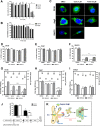
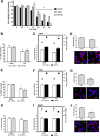
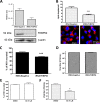

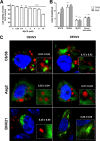

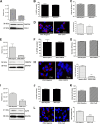
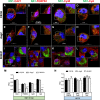





Similar articles
-
The Dengue Virus Nonstructural Protein 1 (NS1) Interacts with the Putative Epigenetic Regulator DIDO1 to Promote Flavivirus Replication in Mosquito Cells.J Virol. 2022 Jun 22;96(12):e0070422. doi: 10.1128/jvi.00704-22. Epub 2022 Jun 2. J Virol. 2022. PMID: 35652656 Free PMC article.
-
The dengue virus non-structural protein 1 (NS1) is secreted from infected mosquito cells via a non-classical caveolin-1-dependent pathway.J Gen Virol. 2017 Aug;98(8):2088-2099. doi: 10.1099/jgv.0.000881. Epub 2017 Jul 31. J Gen Virol. 2017. PMID: 28758625
-
Secretion of Nonstructural Protein 1 of Dengue Virus from Infected Mosquito Cells: Facts and Speculations.J Virol. 2018 Jun 29;92(14):e00275-18. doi: 10.1128/JVI.00275-18. Print 2018 Jul 15. J Virol. 2018. PMID: 29720514 Free PMC article. Review.
-
Inhibition of the Membrane Attack Complex by Dengue Virus NS1 through Interaction with Vitronectin and Terminal Complement Proteins.J Virol. 2016 Oct 14;90(21):9570-9581. doi: 10.1128/JVI.00912-16. Print 2016 Nov 1. J Virol. 2016. PMID: 27512066 Free PMC article.
-
Viral Entry and NS1 as Potential Antiviral Drug Targets.Adv Exp Med Biol. 2018;1062:107-113. doi: 10.1007/978-981-10-8727-1_8. Adv Exp Med Biol. 2018. PMID: 29845528 Review.
Cited by
-
Monitoring Mitochondrial Function in Aedes albopictus C6/36 Cell Line during Dengue Virus Infection.Insects. 2021 Oct 14;12(10):934. doi: 10.3390/insects12100934. Insects. 2021. PMID: 34680703 Free PMC article.
-
Releasing Intracellular NS1 from Mosquito Cells for the Detection of Dengue Virus-Infected Mosquitoes.Viruses. 2020 Sep 29;12(10):1105. doi: 10.3390/v12101105. Viruses. 2020. PMID: 33003584 Free PMC article.
-
Flavivirus infections induce a Golgi stress response in vertebrate and mosquito cells.Sci Rep. 2021 Dec 6;11(1):23489. doi: 10.1038/s41598-021-02929-1. Sci Rep. 2021. PMID: 34873243 Free PMC article.
-
Repurposing of FDA-approved drugs against oligomerization domain of dengue virus NS1 protein: a computational approach.Mol Divers. 2025 Apr;29(2):1619-1639. doi: 10.1007/s11030-024-10936-3. Epub 2024 Jul 17. Mol Divers. 2025. PMID: 39017952
-
Kinesin light chain 1 interacts with NS1 and is a susceptibility factor for dengue virus infection in mosquito cells.J Gen Virol. 2025 Jul;106(7):002132. doi: 10.1099/jgv.0.002132. J Gen Virol. 2025. PMID: 40668623 Free PMC article.
References
-
- Bhatt S, Gething PW, Brady OJ, Messina JP, Farlow AW, Moyes CL, Drake JM, Brownstein JS, Hoen AG, Sankoh O, Myers MF, George DB, Jaenisch T, Wint GRW, Simmons CP, Scott TW, Farrar JJ, Hay SI. 2013. The global distribution and burden of dengue. Nature 496:504–507. doi:10.1038/nature12060. - DOI - PMC - PubMed
Publication types
MeSH terms
Substances
LinkOut - more resources
Full Text Sources
Research Materials
Miscellaneous

